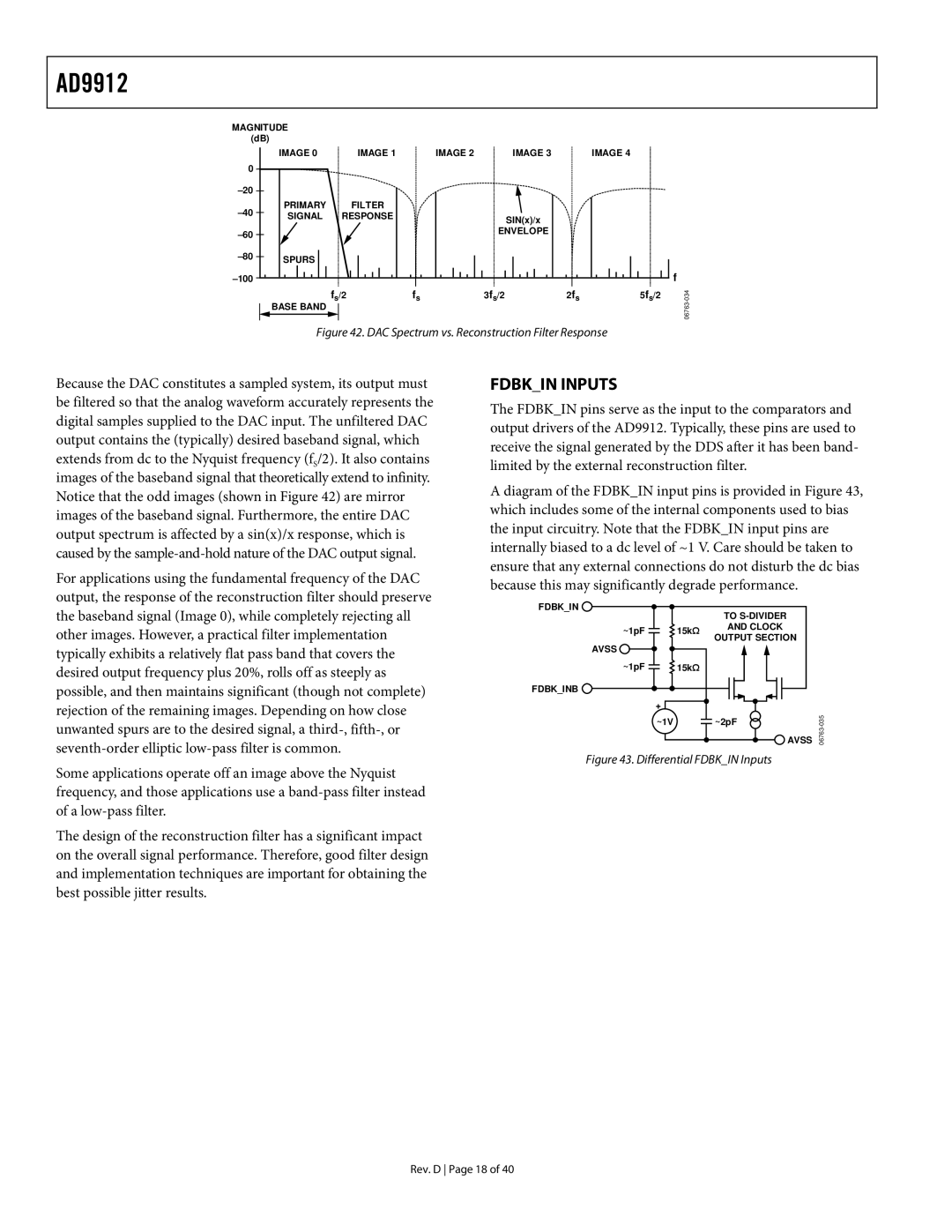
AD9912
MAGNITUDE
(dB)
| IMAGE 0 | IMAGE 1 | IMAGE 2 | IMAGE 3 |
| IMAGE 4 |
0 |
|
|
|
|
|
|
|
|
|
|
|
| |
PRIMARY | FILTER |
|
|
|
| |
SIGNAL | RESPONSE |
| SIN(x)/x |
|
| |
|
|
|
| |||
|
|
| ENVELOPE |
|
| |
|
|
|
|
|
| |
SPURS |
|
|
|
|
| |
|
|
|
|
|
| |
| BASE BAND | fs/2 | fs | 3fs/2 | 2fs | 5fs/2 |
|
|
|
|
|
|
Figure 42. DAC Spectrum vs. Reconstruction Filter Response
f
Because the DAC constitutes a sampled system, its output must be filtered so that the analog waveform accurately represents the digital samples supplied to the DAC input. The unfiltered DAC output contains the (typically) desired baseband signal, which extends from dc to the Nyquist frequency (fS/2). It also contains images of the baseband signal that theoretically extend to infinity. Notice that the odd images (shown in Figure 42) are mirror images of the baseband signal. Furthermore, the entire DAC output spectrum is affected by a sin(x)/x response, which is caused by the
For applications using the fundamental frequency of the DAC output, the response of the reconstruction filter should preserve the baseband signal (Image 0), while completely rejecting all other images. However, a practical filter implementation typically exhibits a relatively flat pass band that covers the desired output frequency plus 20%, rolls off as steeply as possible, and then maintains significant (though not complete) rejection of the remaining images. Depending on how close unwanted spurs are to the desired signal, a
Some applications operate off an image above the Nyquist frequency, and those applications use a
The design of the reconstruction filter has a significant impact on the overall signal performance. Therefore, good filter design and implementation techniques are important for obtaining the best possible jitter results.
FDBK_IN INPUTS
The FDBK_IN pins serve as the input to the comparators and output drivers of the AD9912. Typically, these pins are used to receive the signal generated by the DDS after it has been band- limited by the external reconstruction filter.
A diagram of the FDBK_IN input pins is provided in Figure 43, which includes some of the internal components used to bias the input circuitry. Note that the FDBK_IN input pins are internally biased to a dc level of ~1 V. Care should be taken to ensure that any external connections do not disturb the dc bias because this may significantly degrade performance.
FDBK_IN |
| TO |
| |
|
|
| ||
~1pF | 15kΩ | AND CLOCK |
| |
OUTPUT SECTION | ||||
AVSS |
| |||
|
|
| ||
~1pF | 15kΩ |
|
| |
FDBK_INB |
|
|
| |
+ |
|
|
| |
~1V |
| ~2pF | ||
|
|
| AVSS 06763 | |
Figure 43. Differential FDBK_IN Inputs
Rev. D Page 18 of 40
